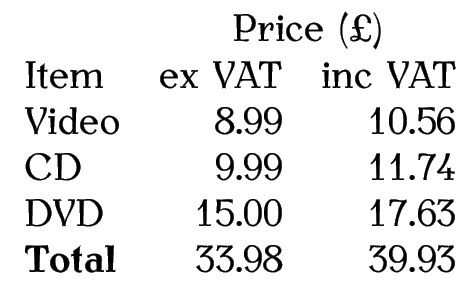4.6.2 Spanning Columns
You may have noticed I omitted the column headers in the above example. [Merging cells in a column of a table] The problem with rewriting the table using r@{.}l to align the decimal point is that the header now needs to span the last two columns. This can be done using the command:
The first mandatory argument <cols spanned> is the number of
columns you want to span, the second argument <col specifier>
indicates how to align this column-spanning entry, the third
argument <text> indicates what should go in this entry. Note
that <col specifier> should only have a single column
specifier, such as {c} or {r}. We can
use \multicolumn to modify an earlier example as
follows:
\begin{tabular}{lrr}
&
\multicolumn{2}{c}{Price (\pounds)}\\
Item & ex VAT & inc VAT\\
Video & 8.99 & 10.56 \\
CD & 9.11 & 10.70 \\
DVD & 15.00 & 17.63 \\
\bfseries Total & 33.10 & 39.89
\end{tabular}
Output:
Here we are spanning two columns, so the first argument to \multicolumn is {2},
we want the entry centred, so the second argument is {c} and the text to go in this entry
is simply {Price (\pounds)}.
[How to alter the alignment
of tabular cells]The \multicolumn command can also be used to override
the alignment of individual entries. Consider
the following example:
\begin{tabular}{lrr}
& Year1 & Year2 \\
Travel & 100,000 & 110,000\\
Equipment & 50,000 & 60,000
\end{tabular}
Output:
In this example, the headers “Year1” and “Year2” would look
better centred, but the rest of the entries in the second
and third columns look best right aligned. We can
use \multicolumn to span just one column, and
use the second argument of \multicolumn to override
the column specification:
\begin{tabular}{lrr}
&
\multicolumn{1}{c}{Year1}
&
\multicolumn{1}{c}{Year2}\\
Travel & 100,000 & 110,000\\
Equipment & 50,000 & 60,000
\end{tabular}
Output:

This book is also available as A4 PDF or 12.8cm x 9.6cm PDF or paperback (ISBN 978-1-909440-00-5).


